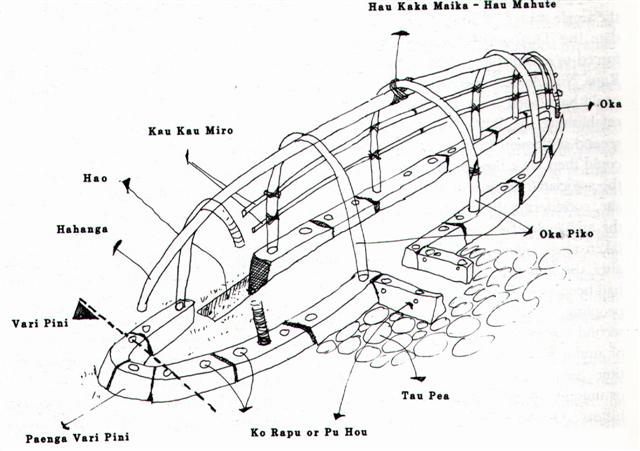3. The pair of glyphs before Venus in Ga2-29 can according to my rule of thumb represent Mercury and Jupiter, and also 'the old land' (where Sun 'goes in the night'):
In Ga2-28 (which like Ga2-27 must be borrowed from Moon in order to reach 240) there is a kind of fish going down. The rhombic shape identifies the fish as the 'mountain' behind which the stars are hidden 'when they are sleeping'. At right there is a haga rave sign, which could illustrates the final curve at the end of this 'season of sleep'. It has are 4 feather signs in front, twice the number of tail feathers for Sun (beaks and wings in manu kake together also make 4): ... Whare-patari, who is credited with introducing the year of twelve months into New Zealand, had a staff with twelve notches on it. He went on a visit to some people called Rua-roa (Long pit) who were famous round about for their extensive knowledge. They inquired of Whare how many months the year had according to his reckoning. He showed them the staff with its twelve notches, one for each month. They replied: 'We are in error since we have but ten months. Are we wrong in lifting our crop of kumara (sweet potato) in the eighth month?' Whare-patari answered: 'You are wrong. Leave them until the tenth month. Know you not that there are two odd feathers in a bird's tail? Likewise there are two odd months in the year.' At Hanga Te Pau I tried to interpret a picture of a hare paega as a calendar. Possibly the pair of Pu Hou holes in the side of the entrance stones (not up in the light) correspond to Ga2-27 and Ga2-28. They seem to be 'reincarnations' of Ko Rapu:
This idea can then be connected with the first kuhane stations on the mainland, those who Saturn (Makoi) visited alone. Ira personifies Sun and he did not go there. If we continue this train of thought, then there are 3 * 7 = 21 kuhane stations in a group, followed by a quartet:
I find it no longer necessary to describe the mirror image to the right of the central point. I assume it could be the same but in reversed order. 25 is a Saturn number and black is my colour for Ahu Akapu. 4 * 29½ + 2 + 25 = 145 and 145 - 59 = 86:
The great short-necked tagata in Ga4-1 together with the following takaure seem to indicate that winter (the season of takaure) is over. 145 = 5 * 29. 364 / 4 = 91 days of summer can be counted forward from henua in Ga4-3. Counted backward to Gb8-30 the ordinal number is 87, which should indicate spring equinox:
Our different models of support seems to work in harmony together.
The number of top holes in the pare paega cycle is 32 - given that we count 2 also for the absent stone and given that we disregard the holes in the pair of entrance stones. If we add also the top holes of the entrance stones the number will be 36 (= 4 + 32 in my table above). |
|||||||||||||||||||||||||||||||||||||||||||||||||||||||||||||||||||||||||||||||||||||||||||||||||||||||||||||||||||||||||||||||||||||||||||||||||||||||||||||||||||||||||||||||||||||||||||||||||||||||||||||||||||||||||||||||||||||||||||||||||||||||||||||||||||||||||||||||||||||||||||||||||||||||





